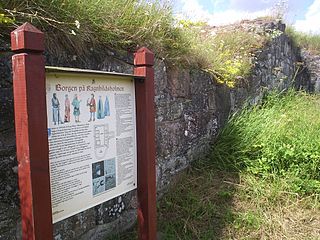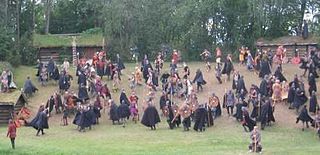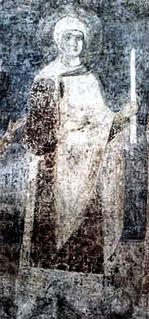This article needs additional citations for verification .(October 2009) (Learn how and when to remove this template message) |
Bjørn Stallare (died July 1030) was an 11th-century Norwegian diplomat and civil servant during the reign of King Olaf II of Norway. [1]

Norway, officially the Kingdom of Norway, is a Nordic country in Northwestern Europe whose territory comprises the western and northernmost portion of the Scandinavian Peninsula; the remote island of Jan Mayen and the archipelago of Svalbard are also part of the Kingdom of Norway. The Antarctic Peter I Island and the sub-Antarctic Bouvet Island are dependent territories and thus not considered part of the kingdom. Norway also lays claim to a section of Antarctica known as Queen Maud Land.

Olaf II Haraldsson, later known as St. Olaf, was King of Norway from 1015 to 1028. He was posthumously given the title Rex Perpetuus Norvegiae and canonised at Nidaros (Trondheim) by Bishop Grimkell, one year after his death in the Battle of Stiklestad on 29 July 1030. His remains were enshrined in Nidaros Cathedral, built over his burial site. His sainthood encouraged the widespread adoption of the Christian religion among the Vikings / Norsemen in Scandinavia.
Bjørn Stallare was involved in the negotiations in behalf of King Olaf, for his marriage to Ingegerd Olofsdotter, the daughter of King Olof Skötkonung of Sweden. In 1018, King Olof's cousin, Ragnvald Ulfsson, the earl of Västergötland, and the King Olaf's emissaries Björn Stallare and Hjalti Skeggiason arrived at the thing of Uppsala in an attempt to sway the Swedish king to accept peace and as a warrant marry his daughter Ingegerd Olofsdotter to the king of Norway. However, King Olof would not allow the marriage of his daughter to occur. Ingegerd later became the consort of Yaroslav I the Wise of Kiev. [2] [3] [4]

Olof Skötkonung was King of Sweden, son of Eric the Victorious and, according to Icelandic sources, Sigrid the Haughty. He succeeded his father in c. 995. He stands at the threshold of recorded history, since he is the first Swedish ruler about whom there is substantial knowledge. He is regarded as the first king known to have ruled both the Swedes and the Geats.

Ragnvald Ulfsson the Old was a jarl of Västergötland or Östergötland and was married to a Astrid daughter to Eirik Bjoðaskalle, sister of King Olav Tryggvason.
Hjalti Skeggiason was an Icelandic chieftain who supported Gizurr the White for the introduction of Christianity in Iceland, on the Althing in 1000.
King Olaf of Norway and King Olof Skötkonung later agreed to a peace treaty at Kungahälla ca 1020. King Olof was forced to accept a settlement with King Olaf, who already had been married with King Olof's daughter, Astrid Olofsdotter, through the efforts of Ragnvald Ulfsson. Ragnvald had delivered Astrid at Sarpsborg in Norway and she married King Olaf after Christmas of 1019.

Kungahälla was a medieval Viking settlement in southern Bohuslän at a site which is located in Kungälv Municipality in Västra Götaland County in Sweden. It is the site of the former fortification at Ragnhildsholmen.

Sarpsborg[ˈsɑʂbɔr], historically Borg, is a city and municipality in Østfold county, Norway. The administrative centre of the municipality is the city of Sarpsborg.
Bjørn Stallare was long one of King Olaf's closest adviser. However, in 1026 King Olaf lost the Battle of the Helgeå, and the Norwegian nobles rallied round the invading King Cnut the Great of Denmark, forcing King Olaf to flee the country. Björn subsequently entered into an alliance with the King Canute. Later Björn was reconciled with King Olaf. Reportedly Björn supported King Olaf's return to Norway and is believed to have died with him in 1030 at the Battle of Stiklestad (slaget på Stiklestad).

Cnut the Great, also known as Canute, whose father was Sweyn Forkbeard, was King of Denmark, England and Norway; together often referred to as the North Sea Empire. Yet after the deaths of his heirs within a decade of his own, and the Norman conquest of England in 1066, this legacy was lost. He is popularly invoked in the context of the legend of King Canute and the tide, which usually misrepresents him as a deluded monarch believing he has supernatural powers, contrary to the original legend which portrays a wise king who rebuked his courtiers for their fawning behaviour.

The Battle of Stiklestad in 1030 is one of the most famous battles in the history of Norway. In this battle, King Olaf II of Norway was killed. During the pontificate of Pope Alexander III, the Roman Catholic Church declared Olaf a saint in 1164.
During the World War II, Arne Skouen adopted Bjørn Stallare as a pseudonym writing about occupied Oslo.

World War II, also known as the Second World War, was a global war that lasted from 1939 to 1945. The vast majority of the world's countries—including all the great powers—eventually formed two opposing military alliances: the Allies and the Axis. A state of total war emerged, directly involving more than 100 million people from over 30 countries. The major participants threw their entire economic, industrial, and scientific capabilities behind the war effort, blurring the distinction between civilian and military resources. World War II was the deadliest conflict in human history, marked by 50 to 85 million fatalities, most of whom were civilians in the Soviet Union and China. It included massacres, the genocide of the Holocaust, strategic bombing, premeditated death from starvation and disease, and the only use of nuclear weapons in war.

Arne Skouen was a Norwegian journalist, author, film director and film producer.

Oslo is the capital and most populous city of Norway. It constitutes both a county and a municipality. Founded in the year 1040 as Ánslo, and established as a kaupstad or trading place in 1048 by Harald Hardrada, the city was elevated to a bishopric in 1070 and a capital under Haakon V of Norway around 1300. Personal unions with Denmark from 1397 to 1523 and again from 1536 to 1814 reduced its influence, and with Sweden from 1814 to 1905 it functioned as a co-official capital. After being destroyed by a fire in 1624, during the reign of King Christian IV, a new city was built closer to Akershus Fortress and named Christiania in the king's honour. It was established as a municipality (formannskapsdistrikt) on 1 January 1838. The city's name was spelled Kristiania between 1877 and 1897 by state and municipal authorities. In 1925 the city was renamed Oslo.









